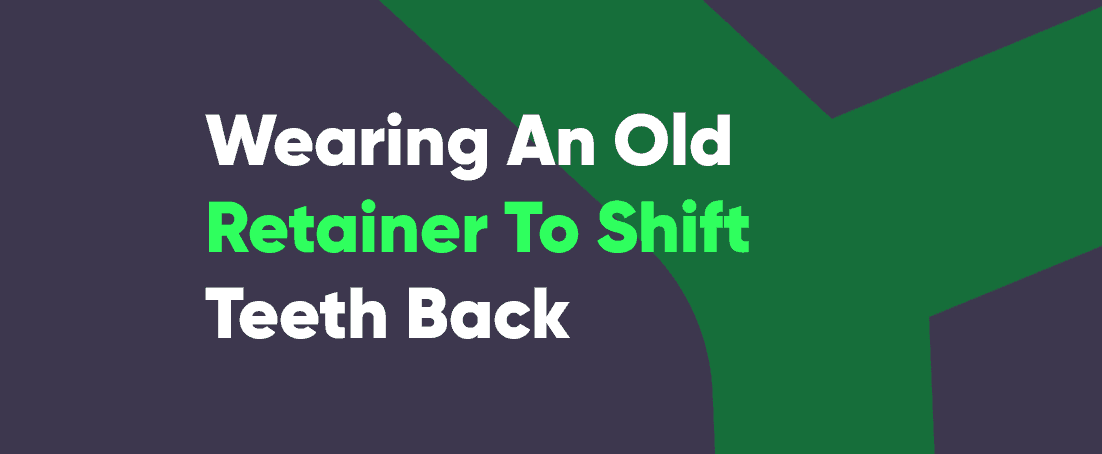Are you considering wearing your old retainer to shift your teeth back? While it might seem like a quick fix, its effectiveness can vary depending on your situation. Understanding the dynamic relationship between tooth relapse and how a retainer functions is crucial.
An article in the British Dental Journal highlights that the struggle between orthodontic correction and the natural “memory” of the surrounding tissues causes teeth to shift after treatment. This suggests that while retainers are crucial for maintaining alignment, they may not suffice as the primary solution for achieving it.
Dive into the details to determine whether using your old retainer to straighten teeth is a wise move or not.
Table of Contents:
Can Wearing an Old Retainer Shift Teeth Back?
Discontinuing retainer wear can lead to teeth reverting to their pre-treatment positions over time. In such cases, you might consider wearing your old retainers thinking they will help shift your teeth back.
But here’s the catch: Retainers aren’t exactly designed to force major tooth movements forever. However, for minor shifts and tweaks, they might offer a helping hand.
The key lies in timing. If you have not worn retainers for a short period (days or a few weeks), your retainer might still fit snugly and gently nudge your slightly moved teeth back into line. In case of longer absences (weeks or months), things get trickier. Your retainer might feel tight or uncomfortable, and its effectiveness in realigning your teeth significantly drops.
Consulting an orthodontist is crucial in cases where you want to shift back your teeth into their ideal positions. They can assess your situation and give your old retainer a thumbs up (or down). They might adjust it for a better fit or craft a new retainer for optimal results. They will guide you whether do you have to wear your retainer forever or not.
Potential Impact On Oral Health
While putting on an old retainer back may seem like a quick fix for shifted teeth, the impact on your oral health could be significant.
A misfitting old retainer can cause excessive pressure, leading to pain, gum irritation, and even potential damage to tooth enamel and roots. Wearing your retainer could put far too much pressure on them if it no longer fits. Incorrect pressure from an ill-fitting retainer can also disrupt your jaw alignment, leading to headaches, temporomandibular joint (TMJ) problems, and difficulty chewing.
An old retainer that doesn’t fit snugly can trap food debris and bacteria, increasing the risk of gum inflammation and infection. Consulting a dentist or orthodontist before using an old retainer is crucial. They can assess your specific situation, ensure a proper fit, and recommend the safest and most effective approach for realignment.
The Role of Dental Retainers in Orthodontic Treatment
Dental retainers preserve your perfectly aligned teeth that you achieved via orthodontic treatment. But how exactly retainers do this?
After orthodontic treatment, the ligaments and surrounding tissues around your teeth “remember” their previous positions and exert a natural pull, trying to return your teeth to their old alignment. This gradual shift, called orthodontic relapse, may not be readily visible but can occur even after successful treatment.
Retainers work against this relapse, gently holding your teeth in their new, corrected positions. They come in various types, including Hawley retainers (metal wire and acrylic), Essix retainers (clear plastic), and bonded retainers (permanently attached to the back of your teeth). All types of retainers offer unique benefits and suit different needs.
By wearing your retainer as prescribed by the orthodontist, you can consolidate the final alignment achieved through braces or aligners. Regular retainers wear prevents teeth from shifting out of place, maintaining your beautiful straight teeth. If needed, retainers may support minor tooth adjustments.
Recognizing the Need for a Replacement Retainer
To maintain teeth alignment, retainers are supposed to be worn for long duration of time, consistently. They guard the results of your orthodontic treatment and need to be replaced after some time. It’s important to understand that wear and tear, lifestyle changes, or even minor damage can compromise the effectiveness of old retainers.
Remember, timely replacement is key to preventing orthodontic relapse. Don’t wait until your teeth shift significantly to address the issue. Schedule regular checkups with your dentist or orthodontist, and be proactive in discussing retainer replacement needs.
Signs Indicating the Requirement for a New Retainer
Here are some telltale signs you might need a new retainer:
- Loss of fit: If you have been wondering why do my retainers feel loose lately? This indicates a weakening grip and reduced ability to hold your teeth in place.
- Visible damage: Replace a broken retainer right away. Cracks, chips, or warping compromise the retainer’s structure and impact its functionality.
- Tooth movement: Notice even slight shifting of your teeth? It’s a red flag that your current retainer no longer provides sufficient support.
Changes in Orthodontic Treatment Plan
Sometimes, treatment plans evolve during your orthodontic journey, requiring new retainers to adapt to these changes.
Your old retainer, while reliable, might not fit or support your smile’s new goals. This is where your orthodontist’s assistance and advice becomes vital. They can assess your evolving treatment plan and determine if a modified old retainer or a completely new design is needed.
Don’t worry, this doesn’t necessarily mean going back to braces. Your orthodontist may advise you to use new retainers instead of braces for minor adjustments, maintaining your progress. Just remember, keeping your orthodontist in the loop ensures your smile stays on track, no matter where the treatment journey takes it.
Periodic Replacement for Maintenance
Periodic replacements are crucial for optimal oral health and preventing orthodontic relapse. Wear and tear can weaken your retainer over time, reducing its ability to hold teeth in place. A cracked retainer, for example, poses a risk of damage to your teeth and gums.
That’s where routine evaluations with your orthodontist come in. They can assess your old retainer’s condition and recommend timely replacements before issues arise.
Opting for Remi retainers make things easier. They offer free re-impressions anytime and flexible reorder options, ensuring your teeth have the latest safety net they deserve.
Straighten Your Teeth Now!
To sum up, a retainer is made to keep your teeth in place, not to move them, but your old retainer might be helpful in shifting back your teeth in the right circumstances. While it is not designed to move teeth majorly, in certain cases, the retainer might offer a helping hand.
Short breaks (days/week) may still allow minor adjustments if you put on your old retainer back. Longer absences (weeks/months) increase the risk of discomfort and ineffective results. Consulting an orthodontist is essential to assess your situation, ensure a proper fit, and guide you on the safest course of action. Remember, DIY adjustments to the retainer can lead to unexpected harm.

